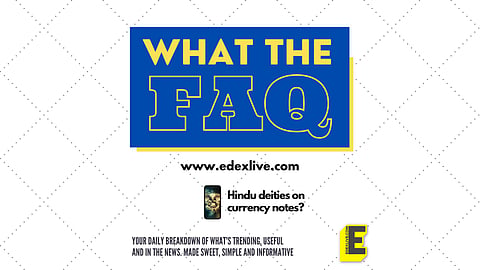

Political parties are scrambling to respond to the latest controversy involving Hindu deities in India. Will we see Lord Ganesha and Goddess Lakshmi on currency notes? Why did the AAP make the proposal in the first place? What are some of the motifs that have been depicted on Indian currency notes? And has Mahatma Gandhi always featured on them? We probe in today's WhatTheFAQ.
What was the AAP's proposal?
This storm was kicked up by the Aam Aadmi Party (AAP) on Wednesday, October 26, when the Chief Minister of Delhi and AAP leader Arvind Kejriwal pitched a proposal to the Bharatiya Janata Party (BJP)-led central government to place the pictures of Hindu deities Lord Ganesha and Goddess Lakshmi on Indian currency notes, alongside that of Mahatma Gandhi. The party claimed that adding pictures of the deities would bring economic "prosperity" to the country.
What was the response to this proposal?
The proposal has not seemed to go down well with the BJP who called it a "face-saving" move and questioned the timing of the move. BJP spokesperson Sambit Patra listed some of the alleged "anti-Hindu" moves of the AAP, which, he said, included the ban on firecrackers during Diwali this week. Patra also claimed that Kejriwal had once "laughed" at the exodus of Kashmiri Pandits.
The Indian National Congress has also lashed out at Kejriwal for playing "vote politics" ahead of the polls in Gujarat. According to ANI, Congress spokesperson Sandeep Dixit called Kejriwal's AAP the "B-team" of the BJP and the Rashtriya Swayamsevak Sangh (RSS).
Claims and proposals aside, who has the final say on currency notes?
The proposal might have been made to the central government, but according to the Reserve Bank of India Act, 1934, it is the RBI that has the "sole right" to issue bank notes in India. It is the central board of the RBI that decides the design of currency notes, which is then to be approved by the Central government. In fact, the RBI has a department dedicated to managing and regulating currency notes. This is the Department of Currency Management, which takes note of any policy issues regarding the design or distribution of currency notes in India.
How have currency notes evolved in independent India?
Until the Republic of India was established in 1950, the Government of India merely re-designed the notes that were in circulation at the time of independence. The portrait of British monarch King George VI was replaced with the National Emblem of India, the Lion Capital from the Ashoka Pillar. This happened in 1949 and the denomination of the currency in circulation at the time was Rupee 1. Then in 1950, the first banknotes of the Republic of India were published in the denominations of Rupees 2, 5, 10 and 100.
Has Indian currency always featured Mahatma Gandhi?
Although Mahatma Gandhi's portrait was in the mix for consideration since the very first redesign, he only made an appearance on Indian currency notes in 1969 as part of a special series to mark his centenary birthday. Then, in 1987, Gandhi's portrait was used on the Rupee 500 currency notes. Only in 1996 did the RBI introduce the Mahatma Gandhi series, with his portrait on currencies of all denominations. Since then, Gandhi has been the ubiquitous face on Indian currency notes.
What are some of the other symbols that have been used on currency notes?
While Mahatma Gandhi has been the only portrait used on Indian currency notes, over the years, the RBI has included various facets of India's history and contemporary accomplishments on the notes. These include the oil rig, the Aryabhatta satellite, the Konark Wheel, a depiction of farm mechanisation, the Hirakud Dam, peacock and the Shalimar Garden. Mount Kanchenjunga, the Parliament, a depiction of Gandhi's Dandi March are some of the motifs on notes Indians might recall from the early 2000s. Then when the Modi government demonetised the Rs 500 and Rs 1000 notes and introduced the Rs 200 and Rs 2000 notes, other motifs such as the Sanchi Stupa, the Red Fort, the Mangalyaan, Rani Ki Vav (The Queen's Stepwell) and the Hampi with Chariot were featured.
